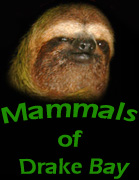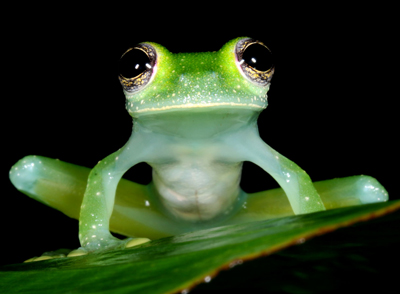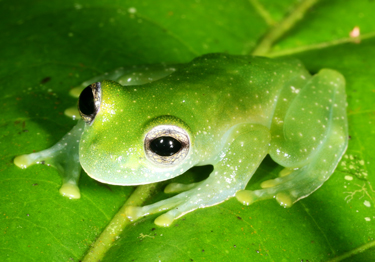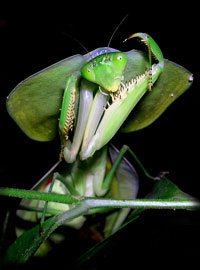|
Discover the
hidden treasures of Drake Bay, Costa Rica with Tracie "The Bug Lady" .

Home

Tour
Basics

Meet the Bug
Lady

Tales from the
Edge

Media

Reservations

Links



Facts about Drake Bay, Costa Rica

Travel To Drake Bay

Drake Bay Area Map

Hotel Information

Tips for Travelers

Tours

Recommended
Reading





|
|
|
|
|
|
|
|
      |
|
|
|
|
|
The Dusty Glass Frog |
|
Teratohyla
pulveratum |
|

Shiny
white dots scattered throughout it's top side give this lovely
frog the appearance of having been sprinkled with moon dust,
explaining it's common name. Adults measure between 22 and 33
millimeters.
Viewed
from beneath, the Dusty Glass Frog is completely transparent.
It's heart, liver and intestines are covered with a white
lining, but the red ventral vein is visible as well as the
frog's bluish green bones. Interestingly, a gravid female's
unfertilized eggs can also be seen through her transparent
belly.
|
 This
frog can be found from sea level to 850 meters above sea level on the
Caribbean Slope and in the Southern Pacific regions of Costa
Rica. Adults live and breed along forested streams.
Males generally
frequent the forest canopy and call
from perches three to eight meters above fast moving streams
and rivers, making encounters a very rare treat.
Groups of calling males may include anywhere from two to
five individuals, each one defending it's own territory. |
|
|
|
|
 If
a male is successful in attracting a female, they will mate
and the female will typically lay her eggs on the upper
surface of a leaf overhanging the water. If
a male is successful in attracting a female, they will mate
and the female will typically lay her eggs on the upper
surface of a leaf overhanging the water.
Clutches include about 50 eggs which are housed in a
thick, clear jelly mass about the size of a golf ball. The
egg clutch pictured here was photographed in Drake Bay
during the month of August.
Unlike many members of it's genus, Dusty Glass Frog males do
not appear to partake in parental care. The thick jelly mass
surrounding the eggs apparently provides them with some
protection from dehydration and predation.
|
|
 This
frog's tadpoles were only described by scientists in
2004, here in Costa Rica. As occurs with other glass
frogs, the tadpoles of this species have a red
coloration. This
frog's tadpoles were only described by scientists in
2004, here in Costa Rica. As occurs with other glass
frogs, the tadpoles of this species have a red
coloration.
Because their skin is transparent, it is the red blood
in their internal organs which gives tadpoles their
color.
|
|
|
After hatching, tadpoles
generally squirm from the egg
clutch until they fall and sink to the bottom of a stream.
 Once they reach the bottom, they lodge themselves between
rocks and under the leaf litter where they scavenge for the
small particles of organic matter on which they feed. Once they reach the bottom, they lodge themselves between
rocks and under the leaf litter where they scavenge for the
small particles of organic matter on which they feed.
|
|
References:
Hoffmann, H.
2004 Description of the previously unknown tadpole of
Hyalinobatrachium pulveratum (Anura: Centrolenidea)
Available from:
http://www.biologia.ucr.ac.cr/rbt/attachments/volumes/vol52-1/27-HOFFMANN-219-228.pdf
Kubicki, B. 2007
Costa Rica Glass Frogs
Editorial INBio
Leenders, T.
2001 A Guide to Amphibians and Reptiles of Costa Rica
Zona Tropical
Savage, J. 2002 The Amphibians and Reptiles of
Costa Rica University of Chicago Press
|

|
|
|
|
|
|
The Frog
Files





     






 |



 Alien Earthlings
Alien Earthlings  The
Dark Side
The
Dark Side













 If
a male is successful in attracting a female, they will mate
and the female will typically lay her eggs on the upper
surface of a leaf overhanging the water.
If
a male is successful in attracting a female, they will mate
and the female will typically lay her eggs on the upper
surface of a leaf overhanging the water.  This
frog's tadpoles were only described by scientists in
2004, here in Costa Rica. As occurs with other glass
frogs, the tadpoles of this species have a red
coloration.
This
frog's tadpoles were only described by scientists in
2004, here in Costa Rica. As occurs with other glass
frogs, the tadpoles of this species have a red
coloration.
 Once they reach the bottom, they lodge themselves between
rocks and under the leaf litter where they scavenge for the
small particles of organic matter on which they feed.
Once they reach the bottom, they lodge themselves between
rocks and under the leaf litter where they scavenge for the
small particles of organic matter on which they feed.







